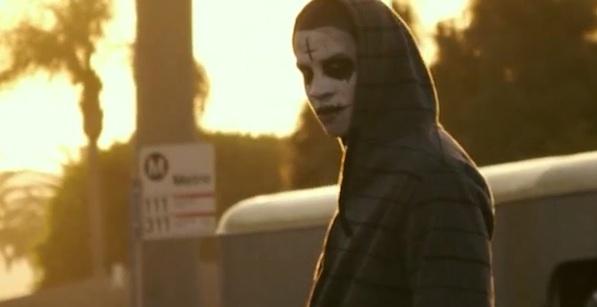It’s a bizarre but indisputable fact that when we talk about summer-blockbuster movies, the annual apex of multiplex escapism, we are frequently talking about entertainments that toy with the complete annihilation of life as we know it. Whether pitting mankind against alien invasion (Edge of Tomorrow, Transformers: Age of Extinction), environmental catastrophe (Snowpiercer), monkey trouble (Dawn of the Planet of the Apes), friendly fascism (The Purge: Anarchy) or some mysterious occurrence we can only guess at (The Rover), this year’s summer sci-fi crop sees the future as more perilous and precarious than ever.
You can read plenty into this ever-more-nihilistic depiction of tomorrow in popular entertainment. Does it reflect escalating fears of global warming? Disillusion about the economy and global politics? Religious apocalypticism? Or just the desire to see bigger and bigger things go boom via CGI effects?
All of the above, no doubt. But as much as today’s more fantastical (and final) versions of the seventies disaster movie amplify current mass psychology, these themes are nothing new to movies. Indeed, behind every mega-buck 2014 mallflick there’s at least a few films who did it earlier, cheaper, and often with more idiosyncratic imagination and/or campy flair. For your viewing pleasure, let’s take a short stroll through a few sci-fi subgenres well-presented at the multiplex this summer, finding their variably-guilty-pleasure equivalents in the annals of indie, exploitation, and experimental flicks.
In cinema’s first decades, the future was usually a happy, even silly place, as in Georges Méliès’ goofy cosmic odysseys like A Trip to the Moon—in which other worlds reassured visitors with grinning chorus girls. One of the biggest early-talkie hits was Just Imagine, a Hollywood mix of elaborate futuristic sets, goofy comedy and musical numbers, set in a 1980 so automated that babies come from vending machines. Yet that film is forgotten now, while Fritz Lang’s Metropolis (1927) is by far the most famous sci-fi film of the 20th century’s first half. At the time, however, that cautionary dystopian vision was an expensive flop that nearly bankrupted its German studio.
It took nearly a quarter-century more for sci-fi to suddenly become a prominent movie genre, and that hasn’t changed in the decades since. The original impetus was present-tense: The atomic annihilation that capped World War II would hover as a global threat in that ersatz peacetime known as the Cold War. The most fanciful and most popular cinematic consequence of “the bomb” was the birth (or unearthing) of Angry Giant Monsters.
The original 1954 Japanese Godzilla cast the longest shadow of all that subgenre’s prototypes, extending not just to this season’s surprisingly good U.S. remake but to such Nippon creature features as Death Kappa. Tomoo Haraguchi’s 2010 film is a deliberately cheesy tribute to the silliest movies in a long backlog of increasingly ridiculous knockoffs. (Remember Godzilla’s 1970s battles against King Kong and the Smog Monster?)
As early as 1951’s Five, more serious films were imagining a stark future in which the few humans left struggle to survive after the Big One is dropped. Two decade later, newly ecology-conscious filmmakers made several films in that mode, from cult hit A Boy and His Dog and big-budget bomb Damnation Alley (a movie 20th Century Fox thought would easily outgross its concurrent Star Wars) to such generally overlooked minimalist narratives as Peter Fonda’s Idaho Transfer (1973) and Glen and Randa (1971).
The latter, from Jim McBride of the notorious faux-documentary David Holzman’s Diary four years earlier, was a hauntingly nihilistic vision whose childlike titular characters stumble though a devastated landscape decades after civilization has nuked itself. With them, humanity is going out with a whimper—the bang has already happened.
Another classic sci-fi flick means by which mankind winnows its ranks, ensuring survival but only for the fittest, is through class warfare: Haves vs. Have Nots in extremis, as illustrated by futuristic allegories from Soylent Green to the ongoing Hunger Games films. The Purge’s clever exaggeration of tough-on-crime, high-on-guns conservatism (elaborated in current sequel The Purge: Anarchy) has plenty of inspirational predecessors.
Among the most coldly credible of them is Peter Watkins’ 1971 Punishment Park, a quasi-documentary in which anti-war youths deemed dangerous by the government are “invited” to “play” Capture the Flag in the desert. If they win, they’ll be freed; if they lose, they’ll get a soldier’s bullet in the head instead. But as the film goes on, it becomes increasingly obvious that winning is a ruse, not a real option. Released—barely—at the height of Vietnam War protests, Park was itself considered “anti-American,” “Communist” and otherwise inflammatory by many.
If space aliens, monsters, radiation and inhumanity to man can’t finish us off, there’s always disease. It’s perhaps the reigning current sci-fi movie catastrophe, if you take into account the ubiquitousness of zombie outbreaks in recent years. While you’re waiting for that World War Z sequel, a new Walking Dead season, or just the gorebath of this summer’s already-on-VOD sequel Cabin Fever: Patient Zero, you can while away eighty-five minutes with the non-zom epidemic of Maxi Dejoie’s Italian mockdoc The Gerber Syndrome. It’s a viral contagion that sweeps across Europe, making people sweaty, spazzy, crazy and grabby:
If we take movies as prophecy, then it’s increasingly clear that our future looks anything but bright. If contemporary cinema has taught us anything, however, it’s that where there’s a looming danger to Planet Earth, there’s also usually a superhero waiting in the wings to save us all. Today, Marvel Comics constitute a literary body more important to more filmgoers than the entire history of literary novels put together. This is a fairly new development. But even sixty-plus years ago, there was precedent, as the following clip from a big-screen serial derived from an early television series makes clear. Captain Video had it all down, including global warming:




